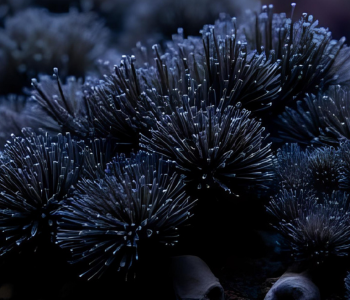Planted aquariums are a beautiful blend of nature and design, offering a calming space filled with lush greenery and vibrant aquatic life. But one common menace that can quickly disrupt this harmony is Black Brush Algae (BBA). Often dreaded by aquarium enthusiasts and home gardeners alike, this stubborn algae species is not only unsightly but also difficult to remove once it takes hold.
If you’ve noticed black or dark grey, fuzzy tufts on your plants, decorations, or filter outlets, chances are you're dealing with Black Brush Algae. But don’t worry — this blog will guide you through how to get rid of black brush algae in planted aquariums, using proven methods, preventive steps, and must-have aquatic plants and treatments.
What is Black Brush Algae?
Black Brush Algae (BBA), also called black beard algae, belongs to the red algae family. It typically appears as small, dark, fuzzy tufts on plant leaves, driftwood, filters, and even aquarium glass. While it may start small, it can quickly overrun your planted aquarium, outcompeting beneficial algae and plants.
Common causes of black brush algae include:
-
Inconsistent or excessive light exposure
-
High organic waste levels
-
Imbalanced CO₂ levels
-
Poor water flow or oxygenation
-
Introduction via contaminated plants or décor
This algae thrives in low CO₂ environments and areas with high water movement, making your filter outlet or corners of the tank prime real estate for BBA.
Why is BBA a Problem in Planted Aquariums?
-
Aesthetics: It turns a vibrant green aquascape into a gloomy mess.
-
Plant Health: It grows on plant leaves, blocking light and hindering photosynthesis.
-
Hard to Remove: It attaches stubbornly to surfaces and often comes back if not addressed at the root.
-
Alters Ecosystem Balance: It can shift the nutrient dynamics of your tank.
How to Identify Black Brush Algae
Before we discuss treatments, ensure you're indeed dealing with BBA. Here's how to spot it:
-
Color: Dark grey to black (sometimes deep green)
-
Texture: Soft and fuzzy, but holds strongly to surfaces
-
Location: Most commonly on plant edges, filter outputs, rocks, and wood
-
Length: Grows in short tufts, usually 1–3 mm, but can get longer
How to Get Rid of Black Brush Algae in Planted Aquariums
Eliminating BBA isn’t about a quick fix—it’s about restoring balance in your tank’s ecosystem. Here are the most effective strategies to get rid of it:
1. Improve CO₂ Injection or Supplementation
Low CO₂ levels are a primary reason BBA thrives. Consider:
-
Using a CO₂ diffuser or injector system
-
Liquid carbon supplements like Seachem Excel (use carefully!)
-
Ensuring consistent CO₂ levels (not just during lighting hours)
Liquid carbon can also be spot-treated—turn off the filter, use a syringe to apply directly on BBA, wait 10–15 minutes, then restart water flow.
2. Manual Removal
Though tedious, manual removal helps control its spread:
-
Trim affected leaves of plants
-
Use a toothbrush to scrub BBA off driftwood and rocks
-
Boil or bleach hardscape items (use 1:20 bleach-water solution, soak for 2–3 mins, rinse thoroughly, and dechlorinate)
3. Introduce BBA-Eating Livestock
Certain aquarium inhabitants love to snack on BBA:
-
Siamese Algae Eaters (SAEs) – Best known for eating BBA
-
Amano Shrimp – Effective if BBA is soft and newly formed
-
Otocinclus Catfish – Helps keep algae in check, though not always BBA-specific
-
Nerite Snails – Great for overall algae control
Tip: Always research compatibility before adding new fish or invertebrates.
4. Optimize Lighting Duration and Intensity
BBA thrives in unstable or excessive lighting:
-
Keep lighting between 6–8 hours per day
-
Use a timer for consistency
-
If needed, lower the light intensity or switch to full-spectrum LEDs designed for plant growth
Avoid placing your tank in direct sunlight—it adds to light instability.
5. Maintain Water Quality and Regular Cleaning
An unclean tank encourages algae growth:
-
Perform weekly water changes (25–50%)
-
Remove debris and vacuum the substrate
-
Clean filter media monthly (in old tank water to retain beneficial bacteria)
-
Test water parameters:
-
Ammonia: 0 ppm
-
Nitrite: 0 ppm
-
Nitrate: under 20 ppm
-
Phosphate: low and stable
-
6. Use Aquarium Algae Control Products (With Caution)
If natural methods aren’t sufficient, opt for commercial algae control products:
-
Look for plant-safe and fish-safe formulas
-
Follow dosage instructions carefully
-
Never use copper-based treatments if you have invertebrates
7. Add Fast-Growing Plants to Outcompete Algae
Introducing fast-growing plants helps consume excess nutrients before algae can:
-
Hornwort
-
Water Wisteria
-
Vallisneria
-
Duckweed
-
Amazon Frogbit
These plants not only add beauty but also serve as nutrient sponges.
Preventing Black Brush Algae in the Future
Once your tank is clean, prevention is key. Follow these tips:
-
Quarantine new plants or decorations
-
Don’t overfeed fish (excess food = excess nutrients)
-
Use high-quality substrate and fertilizers balanced for aquatic plants
-
Keep CO₂ levels and lighting consistent
-
Introduce natural algae grazers early on
Best Aquatic Plants for Algae-Prone Tanks
Some plants are more resilient to algae and grow fast enough to compete with BBA. These include:
-
Java Fern – Hardy and low-maintenance
-
Anubias – Grows well even in low light
-
Cryptocoryne – Great background plant
-
Duckweed – Floating plant that reduces light and absorbs nutrients
-
Vallisneria – Ideal for long tanks and fast nutrient uptake
Where to Buy Aquatic Plants?
Looking to upgrade your planted aquarium or restock your aquatic greenery with fast-growing, algae-combatting species?
Buy premium, healthy aquatic plants from Paudhewale — your trusted partner for all things green and growing. Whether you’re a beginner or a seasoned gardener with an eye for aquascaping, Paudhewale has you covered with curated collections and doorstep delivery.


